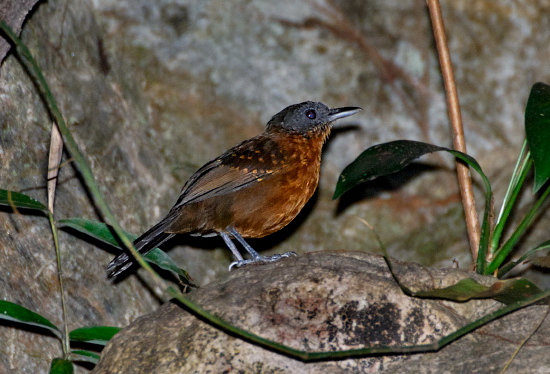m (link) |
m |
||
| Line 1: | Line 1: | ||
| + | [[Image:Caura_Antbird.jpg|thumb|550px|right|Female photographed by Aracari in Serra do Aracá, Amazonas, [[Brazil]].]] | ||
;[[:Category:Schistocichla|Schistocichla]] caurensis | ;[[:Category:Schistocichla|Schistocichla]] caurensis | ||
| − | |||
==Identification== | ==Identification== | ||
| − | This species is similar to the [[Spot-winged Antbird]] and the Roraiman Antbird (the latter is a recent split from the Spot-winged Antbird). At ca. 15 cm both are smaller than the Caura Antbird, which has a total length of ca. 19 cm. The male Caura Antbird is best separated from both species by its red eyes and all-dark bill (no pale lower mandible). It is also more uniform than the clearly two-toned male Spot-winged. The female Caura is potentially more confusing, but is generally darker below than female Spot-winged, has grey legs unlike female Spot-winged of the nominate subspecies (which has pinkish legs), and grey face-sides unlike female subspecies ''infuscata'' of the Spot-winged (which has has brownish-olive face-sides). Females of the Roraiman Antbird share the darker underparts, grey legs and face-sides, and are consequently best separated by their smaller size, proportionally smaller bill, and proportionally longer legs. The overlap in the range of these two species is marginal. All are easily separated by voice. | + | This species is similar to the [[Spot-winged Antbird]] and the Roraiman Antbird (the latter is a recent split from the Spot-winged Antbird). At ca. 15 cm both are smaller than the Caura Antbird, which has a total length of ca. 19 cm. The male Caura Antbird is best separated from both species by its red eyes and all-dark bill (no pale lower mandible). It is also more uniform than the clearly two-toned male Spot-winged. |
| + | |||
| + | The female Caura is potentially more confusing, but is generally darker below than female Spot-winged, has grey legs unlike female Spot-winged of the nominate subspecies (which has pinkish legs), and grey face-sides unlike female subspecies ''infuscata'' of the Spot-winged (which has has brownish-olive face-sides). Females of the Roraiman Antbird share the darker underparts, grey legs and face-sides, and are consequently best separated by their smaller size, proportionally smaller bill, and proportionally longer legs. | ||
| + | |||
| + | The overlap in the range of these two species is marginal. All are easily separated by voice. | ||
==Distribution== | ==Distribution== | ||
Revision as of 10:35, 10 November 2008

- Schistocichla caurensis
Identification
This species is similar to the Spot-winged Antbird and the Roraiman Antbird (the latter is a recent split from the Spot-winged Antbird). At ca. 15 cm both are smaller than the Caura Antbird, which has a total length of ca. 19 cm. The male Caura Antbird is best separated from both species by its red eyes and all-dark bill (no pale lower mandible). It is also more uniform than the clearly two-toned male Spot-winged.
The female Caura is potentially more confusing, but is generally darker below than female Spot-winged, has grey legs unlike female Spot-winged of the nominate subspecies (which has pinkish legs), and grey face-sides unlike female subspecies infuscata of the Spot-winged (which has has brownish-olive face-sides). Females of the Roraiman Antbird share the darker underparts, grey legs and face-sides, and are consequently best separated by their smaller size, proportionally smaller bill, and proportionally longer legs.
The overlap in the range of these two species is marginal. All are easily separated by voice.
Distribution
The range of the Caura Antbird extends through the Guianan Plateau in the Bolívar and Amazonas states in southern Venezuela to extreme northern Amazonas state in Brazil. It may also occur in extreme north-western Roraima in Brazil, although there are no confirmed reports for that area. The bird is endemic to the western and central Tepui region (see "habitat"), but it does not occur on the easternmost Tepui region.
Taxonomy
There are two poorly differentiated subspecies of the Caura Antbird: The northern nominate subspecies and the southern australis. As is the case with all members of the genus Schistocichla, it is often included in the genus Percnostola instead.
Habitat
The Caura Antbird's typical habitat is humid to semi-deciduous forest with a fairly open understorey and large boulders, often in steep terrain, at altitudes between 250 and 700 m (extremes 100-1500 m). They may also be seen at the borders of the forest, especially along mountain streams. Large boulders seem to be a critical component of the habitat of this specialized bird.
Behaviour
They are highly associated with large boulders, often foraging on these boulders or on the ground nearby, exploring its crevices filled with leaf litter and other organic debris for various arthropods. They will also probe in the moss and ferns that may cover these rocks. They also glean their prey with very quick motions from vines and roots over the rocks.
The Caura Antbird may also squeeze themselves into small spaces between the rock and overlying dense tangle of roots, remaining under the protection of these "roofs" for up to a minute. They also vigorously toss dead leaves in the manner of a leaftosser (Sclerurus sp.). (Zimmer, 1999). Apparently it does not attend mixed species flocks of ant swarms. Often forages in pairs.



